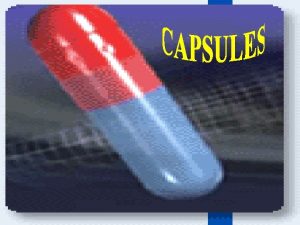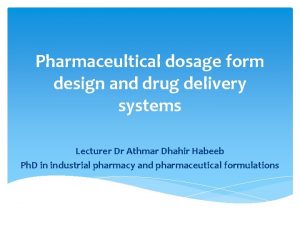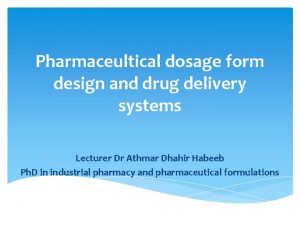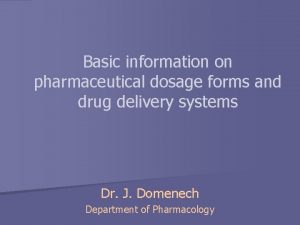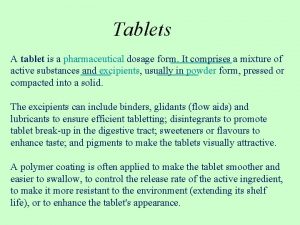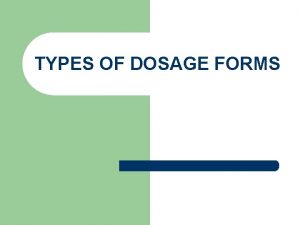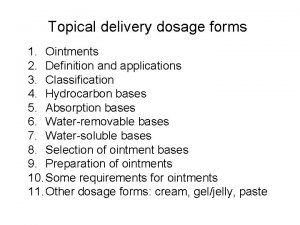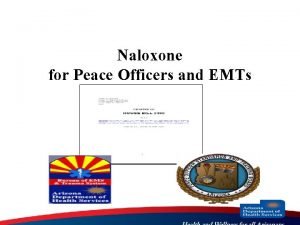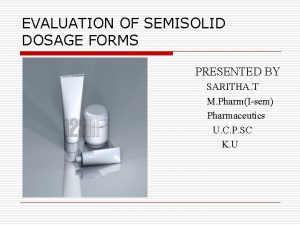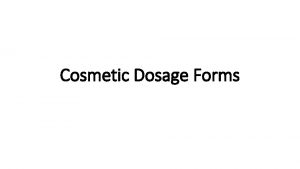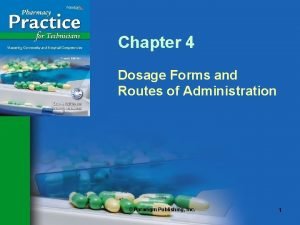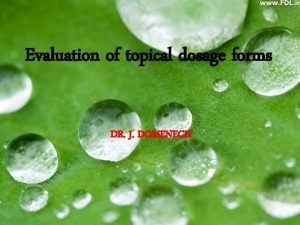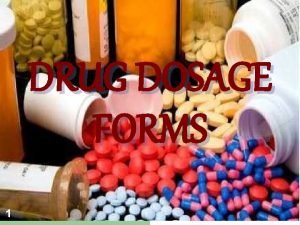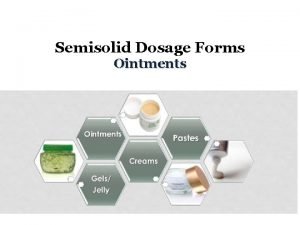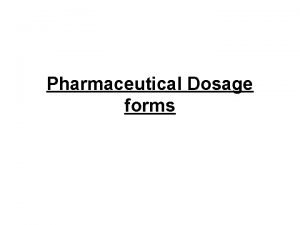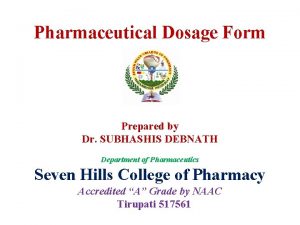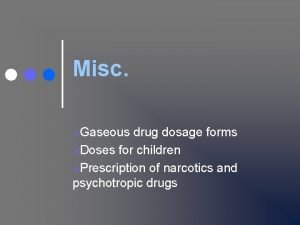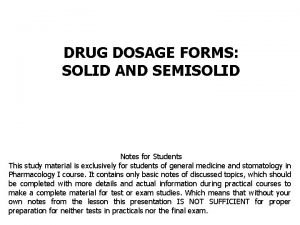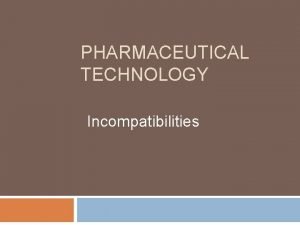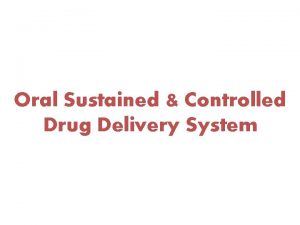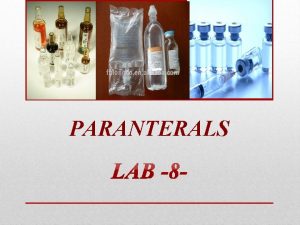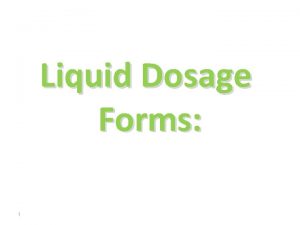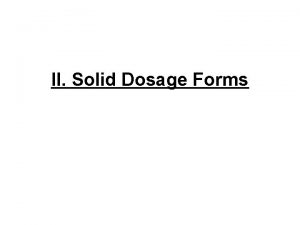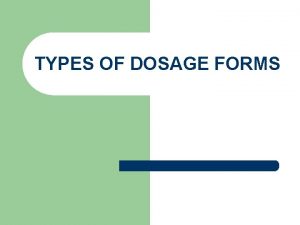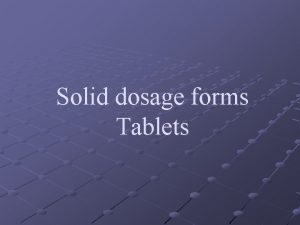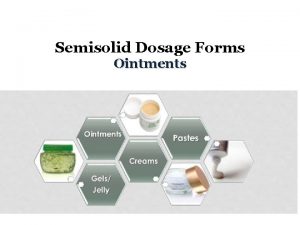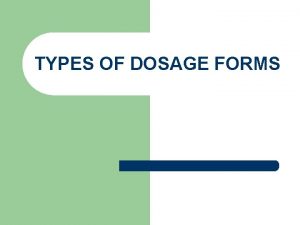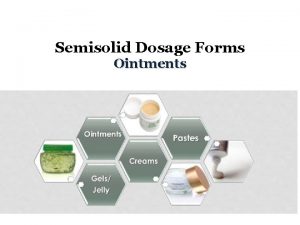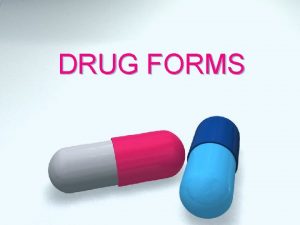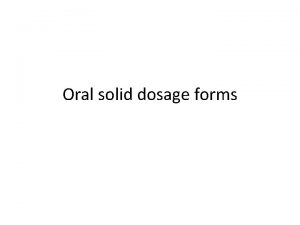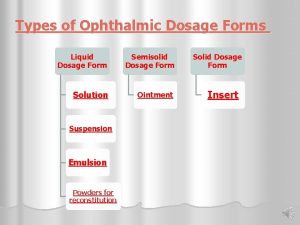PARANTERALS parenterals are dosage forms and therapeutic agents























- Slides: 23

PARANTERALS

parenterals are dosage forms and therapeutic agents that are free from micro-organisms. They belong to a large category (sterile products that include parenterals, ophthalmics, and irrigating preparations). They considered unique among other dosage forms since they are injected through the skin or mucus membrane into the internal body compartments, so they must be free from microbial contamination and from toxic components as well as posses high level of purity.

Pharmacologically parenterals can be divided into: 1 - Solutions ready to be injected. 2 - Dry soluble materials reconstituted prior use. 3 - Dry insoluble materials reconstituted prior use. - Suspensions ready to be injected. 4 5 - Emulsions which are used mostly for lipid supplements, nutrients, but now not used because the main problem in the formulation of parenteral emulsions is the attainment and the maintenance of uniform oil droplet which should be of 1 -5 microns in size as the internal phase.

All these preparations require high level of purity of all ingredients as well as freedom from chemical, physical (particles), microbial contaminants, and pyrogen free (as indicative of a microbiologically clean process). They usually require buffers to stabilize the p. H of the product, and additives to keep them isotonic, as well as stabilizers such as antioxidants. Routes for administration for parenteral preparations includes intravenous, intramuscular, subcutaneous (hypodermic), intradermal, intrathecal or intraspinal (in the cerebrospinal fluid).


Additives Vehicles or solvents Containers Formulation of parenterals

(1) Vehicles or solvents: • The solvents suitable for sterile products are limited to those that produce a little or no tissue irritation which could be either aqueous (water) solvents or nonaqueous solvents. Aqueous (water) solvents non-aqueous solvents The water is the most common since it’s the vehicle for all natural body fluids. This water must be purified, pyrogen free, and sterile. Sometime it’s necessary to eliminate water entirely or in part from the vehicle primarily because of solubility factors or hydrolytic reactions, so the used solvents must be nontoxic, non-irritant, and do not cause sensitivity and do not exert adverse effects on the ingredients of the formulation.

Tonicity contributors Antioxidants Buffers Preservatives Additives Stabilizers

(2) Additives: A variety of ingredients may be added to a formulation to provide the required stability and therapeutic efficacy, they include: A- Buffers: Like acetate, citrate, and phosphate, these added to maintain the required p. H for many products and to decrease slight differences in p. H that may occur. • The p. H of the injectable required for maximum solubility may not be that for maximum stability, so a balance p. H must be achieved to maintain maximum solubility and stability. • The buffer systems are selected with consideration of their effective p. H range, concentration, and their chemical effects to the total product.

B- Antioxidants: these are included in many formulations to protect therapeutic agent from oxidation particularly under accelerated conditions of thermal sterilization. • Note: For products in which the oxygen enters degradation reactions, an antioxidant effect can be achieved by displacing air (O 2) from the container with the product, this can be accomplished by saturation of the liquid with either N 2 or CO 2 and sealing of the final product after displacing the air from the product with gas.

C- Tonicity contributors: Which are compounds that contributing to the isotonicity of a product to reduce the pain of injection in areas with nerve endings. The buffers may act as tonicity contributors as well as stabilizer for the p. H. D- Preservatives: The type used depends on the type of the vehicle used and it’s may be an antibacterial agent in a bacteriostatic concentration which included in the formulation of the products packaged in multiple doses vials, for example benzyl alcohol, benzylkonium chloride, and chlorobutanol.

E- Stabilizers: Like EDTA, the stabilizer serve the same effect as the antioxidant, also it may be added to prevent the leaching of the ferrous that is present in amber vials and ampoules to the constituents. • These added substances may be solubilizers like dimethylacetamide, ethyl alcohol, glycerin, lecithin, povidone. • They also may include antioxidants, chelating agents, buffers, tonicity contributors, antibacterials, antifungals, hydrolysis inhibitors, antifoamings and others for specialized reasons.

These substances must be: 1 - Non-toxic in the quantity administered to the patient. 2 - Do not interfere with therapeutic efficacy. 3 - Do not interfere with the assay of the active ingredient. 4 - Must be active and present when needed throughout the life of the product.

(3) Containers: They must be inert, non-toxic, easy transport, easy sterilize, and easily cleaned. • We have 2 types plastic and glass containers, and each has advantages and disadvantages.

Leaker test Sterility test Evaluation of Parenterals Pyrogen test Clarity test

• 1 - Leaker test: is mainly used to determine the efficiency of the sealing so the incompletely sealed ampoules may be discarded, this is detected by producing a negative pressure within completely sealed ampoule usually in a vacuum chamber, while the ampoule is entirely submerged in deeply colored dye solution usually 0. 5 -1% methylene blue, then the subsequent atmospheric pressure will cause the dye to penetrate any opening, thus make it visible after washing the ampoule to clear it from the dye. • The vials and bottles are not subjected to leaker test because the rubber closure is not rigid, also capillaries of about 15 microns in diameter or smaller may not be detected by this test, also this test is used for colorless solutions and clear containers.

2 - Clarity test: This is done by visual inspecting of each externally clean containers under a good light, baffled against reflection into the eyes and viewed against a black and white background with the contents set in motion with a swirling action. A moving particle is much easier to see than the one that is stationary, but the care must be exercised to avoid introducing air bubbles which are difficult to distinguish from dust particles. The human inspector is subjected to reduction in efficiency by eye strain, fatigue, emotional disturbances that’s why instrumental methods more accurate which depends on the principle of light scattering, light absorption and electrical resistance and these used to obtain particle count and size distribution.

3 - Pyrogen test: The pyrogens are products of the metabolism of the microorganism which will produce rising in body temperature 1 hour after injection. • This test is done by injecting the sample in the vein of 6 rabbits and observe the temperature of the rabbits for 3 hour period by the means of rectal thermometer, if the temperature increases then the product is contaminated and should be rejected, while if only 1 rabbit temperature increased so perform the test with additional 6 rabbits and only 1 rabbit temperature increase out of 12 rabbits is allowed, thus more than 1 rabbit the product will be unaccepted.


4 - Sterility test: After the sterilization step a sample is taken and inoculated on agar, incubated at 37° C for 14 days then observe if any growth developes. Note: The autoclave is used to ensure the sterilization process occurred completely, by utilizing a specific tube as brown color that turns into blue color when sterilization is completed.

types of sterilization process 1 - Physical sterilization: which is eithermal such is dry heat, oven, moist heat, or autoclave, and non-thermal methods such as UV light, filtration, ionizing radial light. 2 - Chemical sterilization: with the utilization of certain chemical agents such as ethylene oxide. Note: the choice of the proper type of sterilization process depends on the physico-chemical properties of the drug, the type of the container as vial or ampoule since in vial the rubber is affected by heat.

The area of preparation of injection must have these properties: 1 -Aseptic Area 2 - Isolated Area 4 - Easily cleaned and sterilize 5 - No large holes are present. 3 - Circulated with filtered air to remove the dust and bacteria. 6 - Working people must ware certain clothing.

 Mikael ferm
Mikael ferm The monophasic liquid dosage form is which type of solution
The monophasic liquid dosage form is which type of solution Filling of hard gelatin capsules slideshare
Filling of hard gelatin capsules slideshare Rate limiting steps in drug absorption
Rate limiting steps in drug absorption Dosage forms and drug delivery systems
Dosage forms and drug delivery systems Parenteral dosage form example
Parenteral dosage form example Sugar coated tablet example
Sugar coated tablet example Dosage form types
Dosage form types Absorption base
Absorption base Define narcan
Define narcan Evaluation parameters of semi solid dosage forms
Evaluation parameters of semi solid dosage forms Simplest dosage form
Simplest dosage form Topical dosage forms
Topical dosage forms Evaluation of paste
Evaluation of paste Dosage form
Dosage form Define the dosage form
Define the dosage form Define dosage form in pharmaceutics
Define dosage form in pharmaceutics Semisolid dosage form classification
Semisolid dosage form classification Yunitron
Yunitron The finely divided solid dosage forms inhaled into nostrils
The finely divided solid dosage forms inhaled into nostrils Gaseous dosage forms
Gaseous dosage forms Semi solid dosage form notes
Semi solid dosage form notes Chemical incompatibility
Chemical incompatibility Difference between sustained release and controlled release
Difference between sustained release and controlled release


